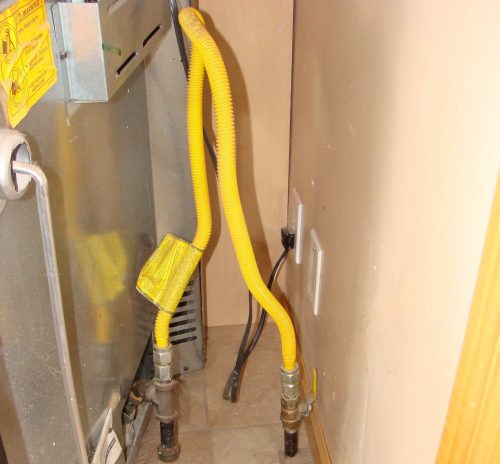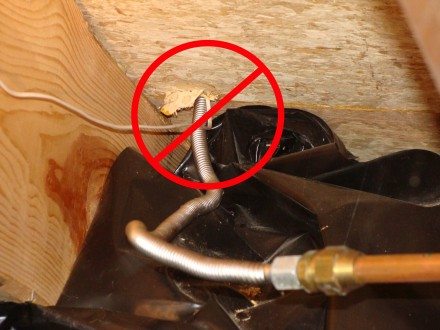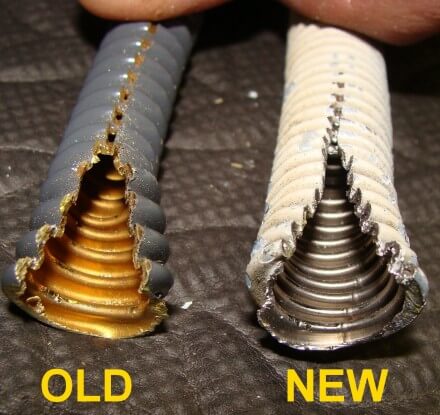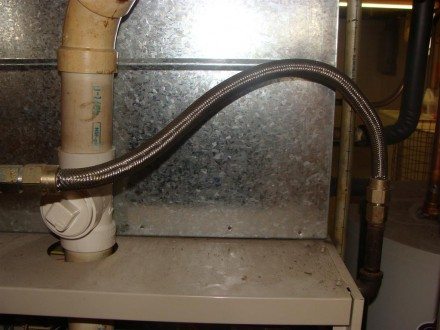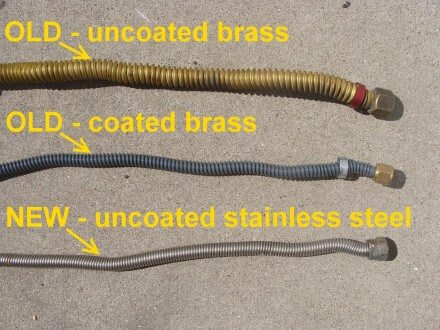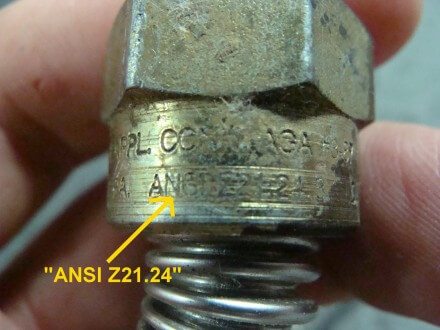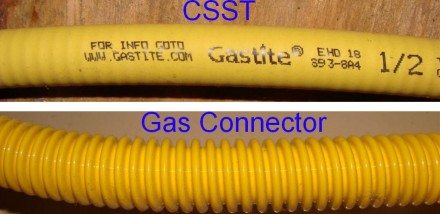Gas appliance connectors aren’t the same as gas piping. Gas appliance connectors are devices that connect gas appliances to gas piping, kind of like a cord connects an electrical appliance to an outlet at the wall. Today I’ll discuss the stuff that I look for while inspecting gas appliance connectors. I’ll cover the most common installation defects, and I’ll go over the differences between new and old connectors. Here’s a video clip of the same: https://youtu.be/nVz6EXmxHAc
Gas Connectors are not a substitute for gas piping. To start, here’s a photo of a gas connector; it’s that corrugated yellow thingy.
Most newer gas connectors look just like this one. A gas connector is used to get from the gas piping to the appliance, and that’s all. Gas connectors should never be used as a substitute for gas piping. This means that if you ever see two connectors joined together, it’s an improper installation. This material is not a flexible gas line. It’s a gas connector.
Gas Connectors should never disappear into a concealed location. If a gas connector disappears into a wall, floor, ceiling, or cabinet of an appliance, it’s an improper installation. Only proper gas piping should be run through walls, floors, cabinets, etc.
Old Gas Connectors should be replaced. The current standard for gas appliance connectors is ANSI Z21.24. I tried to get a copy of those standards so I could say what makes the newer connectors different, but it would have cost me $336 (get out of here), so I did something more interesting. I got my hands on a new gas connector and an old one, and I cut ’em open. Here’s what I found.
As you can see, they’re made from different materials. The new gas connector, which complies with ASNI Z21.24, is made from stainless steel. The old connector obviously isn’t; it’s made from brass, or so I’ve been told. To quickly spot the difference between the old and new connectors, you can usually just look at the outside jacket. Old connectors will typically have a grey coating, like the one shown above left, a braided stainless steel jacket like the type shown below, or they’ll obviously be made of uncoated brass like the one shown far below.
Newer connectors are typically coated with yellow, like the one shown at the beginning of this blog, or will be plain stainless steel, like the one pictured at the bottom of the photo below. If the connector has a grey coating or is made from uncoated brass, it’s old.
To know for sure, you can look closely at the nut, or sometimes at a ring that has been attached to the connector. If it meets ANSI Z21.24, it will say so.
If a gas connector doesn’t meet this standard, it should be replaced. The older gas connectors are much more prone to leakage, making them a latent hazard. The Truth-In-Sale of Housing programs for Minneapolis, Bloomington, and several other cities require replacement of these old connectors. Click the following link for Bloomington’s position on old gas connectors.
Also, the Minnesota code standards for gas appliance connectors can be found in the Minnesota State Fuel Gas Code under section 411.1.3.
Don’t reuse gas connectors. Gas appliance connectors should never be reused. When a gas appliance is replaced, the connector should be replaced at the same time. Oh, and one other thing – don’t confuse gas connectors with Corrugated Stainless Steel Tubing (CSST). CSST is a relatively new type of gas piping that looks similar, but it’s not an appliance connector.

